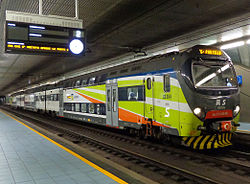| Milan S Lines | |||
|---|---|---|---|
 | |||
 A TSR train at Milano Porta Venezia railway station | |||
| Overview | |||
| Area served | Milan metropolitan area | ||
| Locale | Milan, Lombardy | ||
| Transit type | Commuter rail | ||
| Number of lines | 12 | ||
| Number of stations | 124 | ||
| Daily ridership | 230,000[1] | ||
| Operation | |||
| Began operation | 2004 | ||
| Operator(s) | Trenord | ||
| Infrastructure manager(s) | Rete Ferroviaria Italiana, Ferrovienord | ||
| Rolling stock | E.464, TAF, TSR | ||
| Headway | up to 6 minutes in the central tracks; 30 minutes per direction per line (except for line S7, which runs mostly hourly) | ||
| Technical | |||
| System length | 359 km (223 mi) | ||
| Track gauge | 1,435 mm (4 ft 8+1⁄2 in) standard gauge | ||
| Electrification | 3 kV DC from overhead catenary | ||
| |||
The Milan S Lines constitute the commuter rail system serving the metropolitan area of Milan, Italy.[2] The system comprises 12 lines serving 124 stations, for a total length of 403 km.[3] There are 415 trains per day with a daily ridership of about 230,000.[1]
The core of the system is the Passante, an underground railway running through the city approximately from the north-west to the south-east. Several lines share this track, making the service in the city centre comparable to a metro line[4] or S-Bahn system.
The service timetable is based on a clock-face scheduling. Although operated by different companies, the Milan Metro and the suburban rail service have integrated tickets.
- ^ a b "Passante, Farisè: "Passeggeri +150%. Ora una Circle Line per Milano"" (in Italian). Affari Italiani. Retrieved 28 February 2018.
- ^ "Trenord - Regional & Suburban Railway - S LINES (SUBURBAN LINES)". TRENORD S.r.l. Retrieved 18 November 2016.
- ^ "Suburban and Urban routes". Trenord.it. Retrieved 4 December 2023.
- ^ "Infrastrutture e Mobilità :: S come Suburbano" (in Italian). Trasporti.regione.lombardia.it. Archived from the original on 19 December 2012. Retrieved 10 February 2012.
